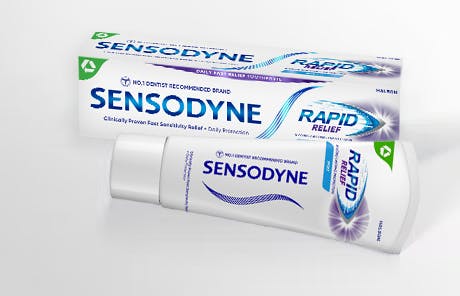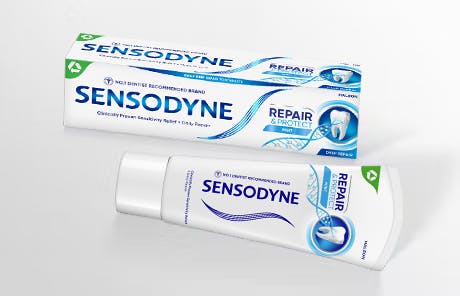Frequently Asked Questions
- All Topics
- Tooth Sensitivity
- How Sensodyne Works
- Sensodyne Ingredients
- Sensodyne Products
- Sensodyne and Whitening
- Enamel Erosion
Tooth Sensitivity
-
Why are my teeth sensitive?
Tooth sensitivity, or dentine hypersensitivity, can develop over time as a result of enamel wear and/or receding gums and can occur when the softer, inner part of the tooth called “dentine" becomes exposed. Thousands of microscopic channels run through the dentine toward the center of the tooth, where the nerves lie. Once the dentine is exposed, certain triggers (such as a cold or hot drink) can stimulate the nerves, resulting in that characteristic short, sharp jolt of tooth sensitivity pain.
Once dentine is exposed, there is no going back, but you can easily get sensitivity protection by brushing with Sensodyne toothpaste twice a day, everyday.
-
What causes sensitive teeth to hurt?
That sharp shock, jolt, or even minor twinge of pain you feel may be caused by these common triggers below:
- Cold foods or drinks
- Breathing in cold air
- Hot foods or drinks
- Sugary foods
- Sour foods
- Brushing your teeth
Learn more about the symptoms of sensitivity and what can cause it.
-
Are sensitive teeth common?
-
Can overbrushing cause sensitive teeth?
-
Are sensitive teeth a sign of a more serious dental problem?
There are many different causes of tooth pain other than tooth sensitivity. For example, a cracked tooth or a cavity (tooth decay). If you are feeling any tooth pain or discomfort, the best thing you can do is visit your dentist and seek professional advice.
-
What can I do to help my sensitive teeth?
Switching to a daily sensitivity toothpaste, like Sensodyne, can protect against the symptoms of sensitive teeth when used twice a day, every day. Sensodyne is specially formulated to provide daily care for sensitive teeth and is the No.1 dentist recommended toothpaste brand for sensitive teeth*.
In addition, talk to your dentist about the symptoms you are experiencing. Your dentist can confirm whether or not tooth sensitivity is the cause of your tooth pain and then advise you on how to best care for sensitive teeth.
*Dentist Survey, UK, 2023. For verification: mystory.gb@haleon.com
How Sensodyne Works
-
How long does Sensodyne toothpaste take to work?
Sensodyne Rapid Relief can relieve sensitivity in as little as 60 seconds. It’s important to continue brushing with Sensodyne toothpaste twice a day, every day, for lasting tooth sensitivity relief. However, if pain/sensitivity still persists visit your dentist as your sensitive teeth may indicate a different problem. To maintain sensitivity relief, continue to use Sensodyne twice a day as your daily toothpaste.
-
How often should I use Sensodyne toothpaste?
Use Sensodyne as your daily toothpaste, brushing twice a day, every day, for lasting care for sensitive teeth. With Sensodyne, you can also get the benefits of fluoride, cavity protection, and fresh breath to help you maintain healthy and sensitivity-free teeth.
Learn more about the ingredients in Sensodyne and how they work to reduce tooth sensitivity.
-
Will my teeth become sensitive again if I stop using Sensodyne?
-
Does Sensodyne toothpaste help prevent cavities?
-
Can I use Sensodyne toothpaste every day?
Yes. Sensodyne is a daily toothpaste specially formulated to relieve and protect against tooth sensitivity* and is the No.1 dentist recommended toothpaste brand for sensitive teeth**. Use it every day to help relieve tooth sensitivity and to also help prevent it from returning.
*With twice daily brushing
**Dentist Survey, UK, 2023. For verification: mystory.gb@haleon.com
Sensodyne Ingredients
-
What are the active ingredients in Sensodyne toothpastes?
-
Does Sensodyne toothpaste have fluoride?
All Sensodyne toothpastes contain fluoride, which is a naturally occurring mineral that rapidly enters mineralized tissue, such as bone and developing teeth. It hardens tooth enamel, protecting against tooth decay (cavities), so you can maintain healthy teeth every day.
Learn more about the ingredients in Sensodyne and how they work to reduce tooth sensitivity.
-
What is stannous fluoride and how is it used in Sensodyne toothpaste?
Stannous fluoride is a type of fluoride that builds a robust layer over the exposed, softer than enamel, inner part of your tooth called dentine, acting like a shield for your sensitive teeth. This layer helps prevent triggers, like hot and cold liquids, from causing pain.
Sensodyne Complete Protection, Sensodyne Repair and Protect, and Sensodyne Rapid Relief toothpastes all contain stannous fluoride.
-
Does Sensodyne toothpaste contain triclosan?
-
Is Sensodyne toothpaste gluten free?
-
Are Sensodyne toothpastes kosher?
Haleon Consumer Healthcare only uses high-quality ingredients in its products. Following a review of the product formulations and supplier documentation, we have not received confirmation from all our suppliers that all individual ingredients are certified as halal and/or kosher. As a result, we have not formally confirmed or labeled the finished products as halal or kosher. Prior to using a product, we recommend you always check the list of ingredients printed on the pack and follow the label instructions.
Sensodyne Products
-
Does Sensodyne toothpaste come in different varieties?
Sensodyne toothpaste comes in many different variations to meet individual needs and preferences. All of our toothpastes contain fluoride, which helps to protect teeth from cavities.
- Sensodyne Rapid Relief (also available in Rapid Relief Extra Fresh and Rapid Relief Whitening)
- Sensodyne Repair and Protect (also available in Repair and Protect Extra Fresh and Repair and Protect Whitening)
- Sensodyne Complete Protection (also available in Complete protection Extra Fresh)
- Sensodyne Sensitivity & Gum (also available in Sensitivity & Gum Whitening)
-
How does Sensodyne Rapid Relief toothpaste work?
Sensodyne Rapid Relief has a unique formula that actively targets sensitive areas of your teeth. It acts to build a protective barrier over sensitive areas of your teeth, helping to protect you from pain.
-
Is Sensodyne Rapid Relief toothpaste right for me?
If you want to beat sensitivity pain fast, Sensodyne Rapid Relief toothpaste provides clinically proven sensitivity relief in just 60 seconds.
Sensodyne Rapid Relief is also available in Extra Fresh and Whitening variants.
-
How often should I use Sensodyne Rapid Relief toothpaste?
Use Sensodyne Rapid Relief (or any Sensodyne toothpaste) as your daily toothpaste, brushing twice a day, for lasting sensitivity relief—along with the benefits of fluoride, cavity protection, and fresh breath—so you can maintain healthy teeth.
-
Is Sensodyne an abrasive toothpaste?
-
Is Sensodyne toothpaste available in a travel-sized tube?
Sensodyne Rapid Relief, Sensodyne Gentle Whitening, and Sensodyne Deep Clean are available in a travel size at major retail outlets, in-store, and online.
-
Can kids use Sensodyne toothpaste?
Sensodyne and Whitening
Enamel Erosion
-
What is enamel erosion?
Enamel erosion occurs when your tooth enamel, the outer, translucent protective layer of your teeth, wears away, which can cause you to experience tooth sensitivity. Enamel wear can happen as a result of teeth grinding, aggressive brushing, or an acidic diet. Once enamel wears away, it cannot grow back.
Not sure if your teeth are at risk? Let's find out if Sensodyne or Pronamel toothpaste is right for you.
For more information on Pronamel, visit Why Pronamel?
-
What causes enamel wear?
Over time, frequent daily intake of acidic foods and drinks—such as fruit juices, carbonated drinks—can wear away your tooth enamel. This is also known as acid erosion. Other causes of enamel wear include teeth grinding and aggressive brushing.
To help protect your teeth against enamel erosion, talk to your dentist and use a fluoride toothpaste specially formulated to help strengthen tooth enamel, such as Pronamel.
For more information on Pronamel, visit Why Pronamel?
-
Can enamel erosion cause sensitive teeth?
Yes. Enamel is the hard, protective surface of the tooth. Over time, if tooth enamel wears away, it exposes the soft, yellow inner layer known as dentine. This can cause tooth sensitivity as the protection the enamel provides to the tooth and the nerves inside is reduced. This is why, if you have enamel erosion, eating ice cream or sipping hot soup can be painful.
For more information on enamel erosion, visit Why Pronamel?
-
Should I use Sensodyne or Pronamel toothpaste?
To find the right toothpaste for you, discuss it with your dentist who can advise what suits you best.
For more information on Pronamel, visit Why Pronamel?







